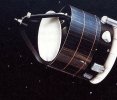Giotto - PSA
Giotto

ESA's first deep space mission, Giotto was designed to help solve the mysteries surrounding Comet Halley by passing as close as possible to the comet's nucleus, which it achieved on 14 March 1986 at a distance of just under 600 km. No-one expected the spacecraft to survive its battering from comet dust during this encounter, but although Giotto was damaged during the flyby, most of its instruments remained operational. The mission was extended to allow a additional encounter with comet Grigg-Skjellerup on 10 July 1992, at a distance of around 200 km. The ingestion of data from Giotto into the Planetary Science Archive took place in 2004, shortly after the PSA was developed. Data from both the Halley encounter and the Giotto Extended Mission to flyby Grigg/Skelerup are available. Note: In addition to the spacecraft data, supporting ground-based observations from the 'Halley Watch' campaign are also available in the PSA. These can be accessed from the 'Earth-Based' tab of the FTP Browser.
Giotto is an international mission and data are jointly archived at PSA and NASA's PDS Small Bodies Node. Access to the Giotto holdings at PDS SBN can be found here.
Giotto Spacecraft Instruments
DIDDust Impact Detector System
A dust impact detector used to measure the mass of dust particles striking Giotto's shield. The detector consists of six sub-systems with the primary aim of recording the impacts of all particles of significant mass. |
EPAEnergetic Particle Analyser
An energetic particles analyser to study electrons, protons and alpha-particles. No public data available yet |
GRERadio Science Experiment
Determination of the Halley mass fluence resulting from atmospheric drag. The GRE compared signals sent at different frequencies from the spacecraft, receiving at S-band and transmitting at both S-band and X-band frequencies. |
HMCHalley Multimeter Camera
HMC used a 16-cm modified Ritchey-Chretien telescope to image the sky onto a set of linear-array detectors. One reticon detector with rotating narrow band filters, and 2 CCDs with fixed red blue and clear filters were used. |
IMSIon Mass Spectrometer
One of three mass spectrometers to measure accurately the relative abundances of both solar and cometary ions in the cometary coma, and to determine ion velocity distributions as a function of position within the coma. |
JPAJohnstone Plasma Analyser
One of two plasma experiments to study the solar wind and charged particles. This instrument measures the three-dimensional energy distribution of positive ions in order to study the interaction between the solar wind and ionised cometary particles. |
MAGMagnetometer
Investigation of the interaction between Comet Halley and the solar wind during the encounter, as well as a study of the interplanetary magnetic field. |
NMSNeutral Mass Spectrometer
One of two mass spectrometers designed to measure gas and dust composition in and around the comet. The Neutral Mass Spectrometer measured the composition and energy of neutral gas in the cometary coma. |
OPEOptical Probe Experiment
Study of the polarized emissivity of the dust and gas in the cometary coma. OPE is a photometer-polarimeter which observes along the spin axis of the spacecraft, looking 'backwards' along the spacecraft track. |
PIAParticle Impact Analyzer
In-situ measurement of the chemical and physical properties of cometary dust particles. Four different detectors are used to sense the impact of a particle and initiate the collection of data for a mass spectrum. |
RPARPA-(Reme) Copernic Plasma Experiment
One of two plasma experiments to study the solar wind and charged particles. The RPA measured velocity distributions of electrons and composition/distribution of thermal positive ions close to the cometary object. No public data available yet |
